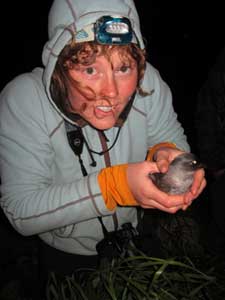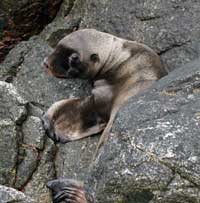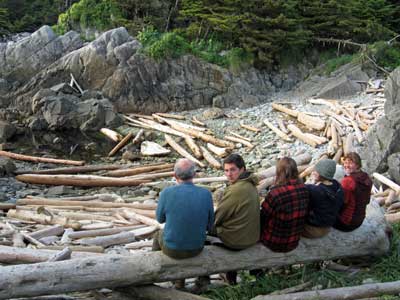Sarah Donohoe, College Intern I
Wildlife Conservation - Juneau

My ADF&G internship as a Steller sea lion surveyor on Lowrie Island was an unforgettable adventure. Lowrie Island is one of the largest Steller sea lion rookeries in the world. The Steller sea lions (SSL's) arrive in mass (safety in numbers!) over the summer to give birth to pups and to mate.
The field team provided on-site observations to contribute to the long-standing population study on Lowrie Island and the surrounding 'outer rocks'. Sea lions generally return to the rookery where they are born for the pupping season. A selection of animals are branded as pups (branding has not occurred within the last few years), which allows us to identify individuals and follow them as they age.

I shadowed veteran observers until I was trained on how to do brand re-sighting. Land surveys included hiking to observation locations to re-sight the branded animals and follow them by watching for key behaviors (mating, nursing, pup interactions, etc). Surveys of the outer islands were conducted by boat. I learned how to drive both a 16ft skiff and a 12ft inflatable. Verification of data was based solely on good photographic evidence; photography was therefore a key component of the work. Other survey responsibilities were noting and photographing entangled or injured animals and other species (like harbor seals, northern fur seals, elephant seals, and whales).
Additionally, I assisted on a grad-school project conducting necropsies on the dead pups we found (12 pups, 1 adult in total). I assisted in organ collection and careful intestine and stomach content lavages, looking specifically for hookworms in pups and for cause of death (drowning, starvation, trauma etc.). The necropsies were a highlight of the summer for me. The organs and functions of various tissue in the marine mammal body system are fascinating and complicated. It was all hands-on and learn-as-you-go. I know I will remember it forever.
Other projects on the island included: sea bird nesting box surveys (ancient murrelets, Cassin's auklets, rhinoceros auklets), beach debris clean-up (looking specifically for debris from the Japanese Tsunami), trail maintenance, and cabin renovations. Responsibilities of a remote-field camp included rain water collection, cabin maintenance, satellite phone communications, radio communications, and, of course, dinner duty.

Working at Lowrie Island solidified my love for Alaska and my desire to work as a wildlife biologist here. Living with passionate and enthusiastic field researchers for two months helped me learn about the dedication and responsibility to excellence that is necessary for good data -- the ultimate goal and fruit of the summer. This internship has led me to strive for the excellence and enthusiasm portrayed in the amazing Lowrie Island research team and to pursue more opportunities to work for the Alaska Department of Fish and Game.
